Birth in the time of coronavirus
This story was produced as part of a larger project led by Marina Riker, a participant in the 2020 Data Fellowship.
Other stories in this series include:
It's one of the silver livings': How COVID-19 pandemic could boost access to maternal health care
She already had a high-risk pregnancy. Then, COVID-19 struck.
Part 1: Birth on demand
Part 2: More than ‘a little snip’
Texas lawmakers aim to make maternal health a priority this year
Part 3: Filling the gap
Our women are dying': Texas lawmakers urged to extend Medicaid to a year after birth for new mothers
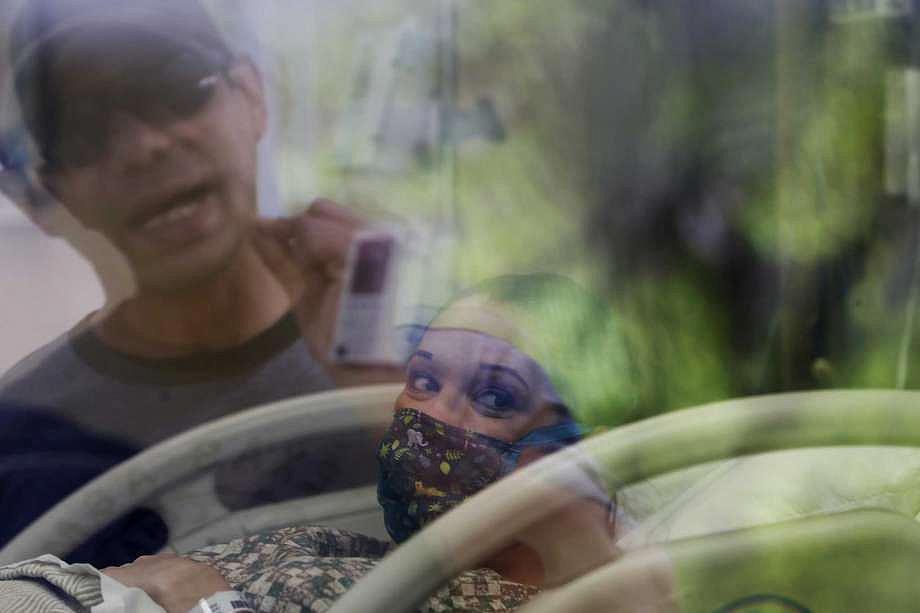
Alex Benavidez, 35, talks with his wife, Kayla, 31, through the window of a maternity room at Uvalde Memorial Hospital on April 12. The couple rushed to the hospital because Kayla was having contractions, but she was sent home to wait until her labor progressed more. They returned early the next morning.
Photos by Jerry Lara
UVALDE — The contractions come in waves, unbearable pain crashing through her body every three minutes.
Kayla Benavidez braces in the passenger seat of the Dodge pickup truck as she and her husband speed through the dark to the hospital, 70 miles away. The speedometer tips over 90 mph.
“You got this,” says Alex Benavidez, scanning the rural Texas highway for deer. “Just keep breathing.”
It’s just after 2:30 a.m., and the half moon is high over the two-lane highway leading from their home in Rocksprings to Uvalde, a community of 16,000 people nestled halfway between San Antonio and the U.S.-Mexico border.
The labor pains are so intense it’s hard for Kayla to speak. But she manages to dial Uvalde’s non-emergency line, which sends three sheriff's deputies zipping to meet them on the outskirts of town.
After arriving at Uvalde Memorial Hospital around 3:20 a.m. on April 13, Alex Benavidez spent the morning watching Kayla labor through the hospital room window. They talked often by phone and video calls. (Jerry Lara | Express-News)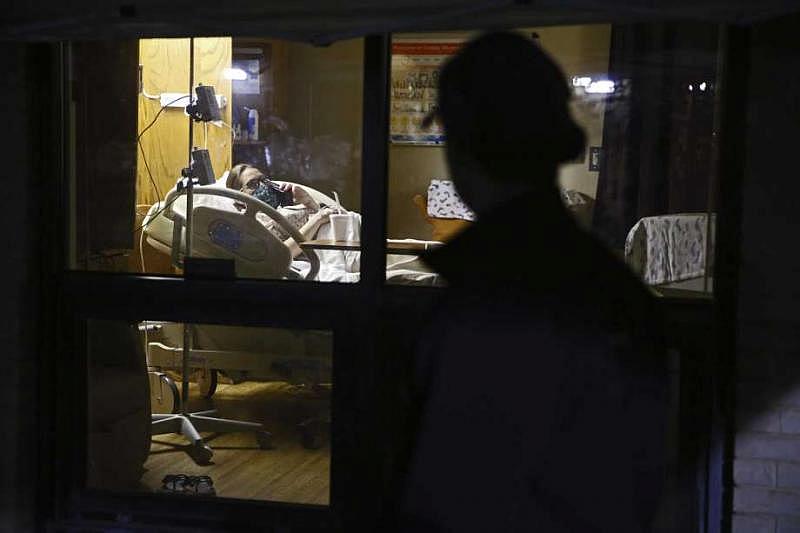
At 3:20 a.m., the motorcade arrives at the hospital — to the only doorway patients are allowed to enter amid the coronavirus pandemic.
A nurse waits with a wheelchair for Kayla. In tears, she assures Alex that he doesn’t have to worry about her. She can do this. Alex tells her to remember her guardian angels; they will watch over her in the hospital room.
He drives three blocks to buy a cup of coffee while waiting to get her room number. He returns to the hospital, pulling into the parking spot closest to the maternity wing, which overlooks a courtyard.
White canopy tents are pitched in front of two delivery suites. Underneath each tent, a single camping chair.
Alex strolls across the grass, past the first two windows, to the third one on the left.
Kayla sees her husband, silhouetted by the bright outdoor lights, as he approaches the window. They meet each others’ eyes.
Separated by the glass, this is how the couple will bring their daughter into the world.
***
Kayla and Alex had been trying for a long time to have a second child, after their daughter, Taegan, was born five years ago.
Alex is a chemical engineer with an oil field company. The couple moved around Texas before settling in his hometown of Rocksprings a year ago, where his parents and grandfather still live. A few months later, they found out Kayla was expecting their second child.
But soon after learning of the pregnancy, Kayla became violently ill. For days, she wouldn’t be able to hold down food or water. Her doctor diagnosed her with hyperemesis gravidarum — morning sickness so severe that it can last for the entire pregnancy, leading to dangerous dehydration and weight loss.
Over the course of nine months, Kayla went to Uvalde Memorial Hospital at least 18 times, she said. She spent nearly half of her pregnancy laying in a hospital bed, getting to know the medical staff. Her doctor, a family-practice physician, would arrive at any hour of the night to check on her. One of her favorite nurses would stay past her shift to care for Kayla.
Alex and Taegan always came to visit. They brought her containers of sliced watermelon: one of Kayla’s strongest pregnancy cravings.
But during her most recent hospital stay in March, the hospital policies changed. Her husband and daughter weren’t allowed inside.
The coronavirus had been spreading silently across the U.S. for weeks. State health and government officials were taking drastic measures to stop it.
On March 26, Uvalde County reported its first case of COVID-19. The next day, Uvalde Memorial Hospital announced on Facebook that even laboring mothers weren’t allowed visitors. “Special arrangements will be made for a single support person for patients who are delivering,” the post read.
Kayla, who’d been planning to have her husband and daughter there to support her during birth, came across the post as she scrolled through Facebook. She panicked.
She called the labor and delivery unit. The nurse apologized to Kayla, saying they knew she’d already been through a rough pregnancy, often away from her family. But special arrangements didn’t mean that Alex could be inside the hospital. Hospital leadership had decided it meant he could watch from outside the window. They could call and video chat, too.
Kayla told the nurse she understood; they just were doing this to keep people safe.
But as soon as she hung up the phone, she began to sob.
After the nurse checked Kayla, she flashes hand signs to Alex in an attempt to update him on how her labor was progressing. (Jerry Lara | Express-News);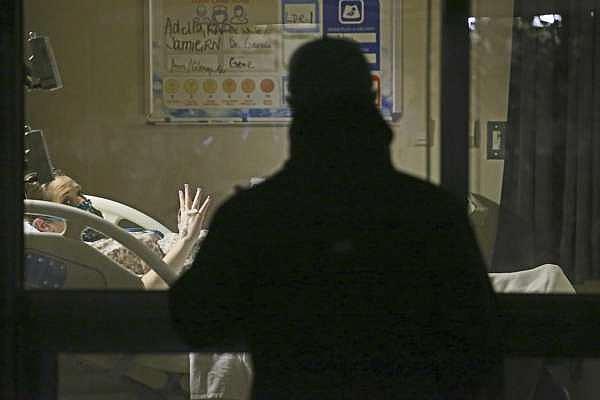
***
That same week in New York, hospital leaders were grappling with the most deadly coronavirus outbreak in the nation. At least two hospital systems announced they had planned to ban partners and birth coaches from delivery rooms, inciting outrage among pregnant women and their families.
The day Uvalde Memorial Hospital announced its policy, the state of New York issued an executive order that women should be allowed at least one support person in the delivery room. “In no hospital in New York will a woman be forced to be alone when she gives birth. Not now, not ever,” said New York Gov. Andrew Cuomo.
When Kayla went into labor two weeks later, even hospitals in San Antonio were allowing, at minimum, one person in the room to support a patient having a baby.
Some hospitals, including University Hospital and Methodist Hospital, are still allowing one partner, plus a certified doula, as long as they don’t have symptoms. Doulas are professionals trained to support laboring women, and their presence has been shown to help women cope with pain, lead to shorter labors and reduce the odds of having a cesarean section — a surgery that demands protective gear such as masks and gowns that are needed in the fight against COVID-19.
After learning about the new policy in Uvalde, some expectant mothers and their families reacted like those in New York, saying the hospital’s decision was cruel and unnecessary in a sparsely populated community with just six confirmed COVID-19 cases.
The hospital argued the policy was necessary to keep newborns, mothers and medical staff safe. Since it was enacted, at least two dozen babies have been born at Uvalde Memorial Hospital.
Unlike major metropolitan hospitals that have multiple floors, Uvalde’s hospital has only 25 licensed inpatient beds in a one-story building. There are only four labor and delivery suites. Families can interact through the windows.
For a moment, Kayla thought about making the trip to a hospital in Hondo, 41 miles from Uvalde. But that would mean delivering with a doctor she’d never met before. She’d grown to trust Uvalde’s nursing staff and her doctor with her life.
When the labor pains arrived a week and a half later and the couple raced 70 miles to the hospital, Kayla realized that there was no way she could’ve made it any farther.
***
Before dawn, a nurse checked to see how Kayla’s labor had progressed. Alex watched intently from outside the window. (Jerry Lara | Express-News)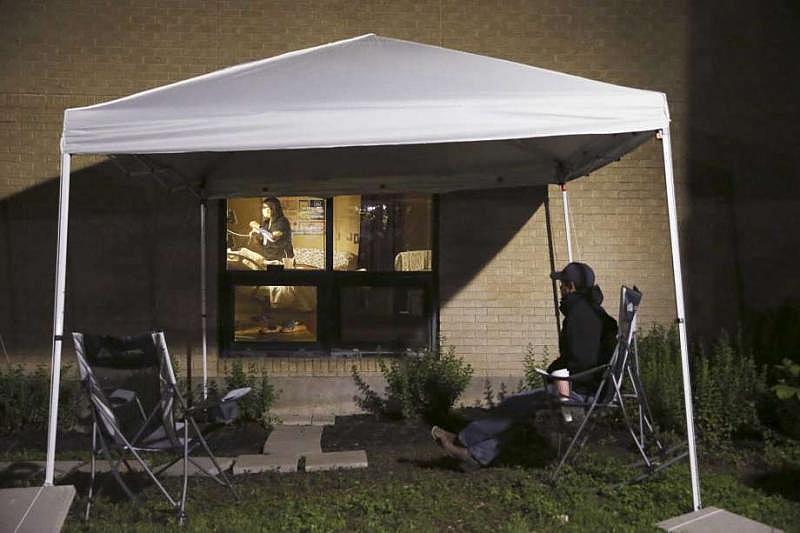
Hours before sunrise, Alex watched his wife from the camping chair. He buried his hands in his jacket pockets as he waited in the 55-degree predawn chill.
The delivery room window stretches from the ceiling to about 2 feet above ground. A baby warmer was positioned next to the glass. Kayla, wearing a hand-sewn face mask, rested in the bed at the center of the room.
Just before 5 a.m., a nurse entered, wearing a surgical mask and gloves. She walked to the window, waved to Alex, then lowered the blinds. He had no idea what was happening.
But after a few minutes, the blinds were reopened. He stood inches from the glass, communicating silently with Kayla. She pulled the face mask down to her chin, revealing her smile. She blew him a kiss.
Kayla had slept only for an hour and a half the day before, and hadn’t slept well for the last three nights because of contractions. And anxiety.
If something were to go wrong, Alex wouldn’t be there.
She could call him on the phone, but what if she were forced to hang up?
But most of all, she couldn't stop thinking about how she didn’t want to fall asleep once her daughter was born. When she gave birth to Taegan, Alex cut the umbilical cord, put on her first diaper, gave her the first bath, and held the baby on his chest for almost the entire hospital stay.
Alex kept reassuring her that she needed to rest after the birth. But Kayla couldn’t stop worrying she’d be taking something away from him if he couldn’t watch her hold the baby through the night.
Kayla said her contractions were unbearably painful when she arrived at the hospital. Nurses started her on pain medication, but Kayla didn’t feel relief until getting an epidural later in the day.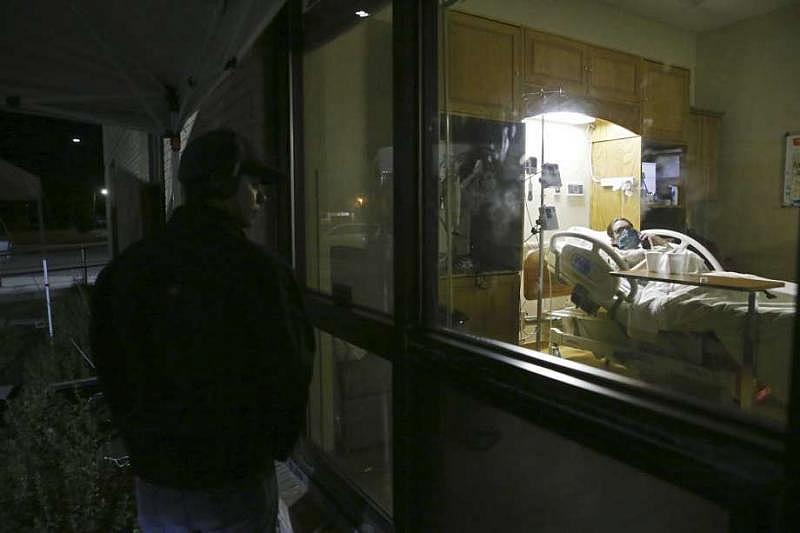
***
That afternoon, hours into labor, Kayla texted Alex: did he want to make a bet on how much the baby was going to weigh?
Yes, he replied. His bet: 7 pounds 8 ounces. She said 6 pounds 7 ounces.
Once Kayla got an epidural and the pain subsided, they talked about the food she wanted Alex to pick up for her after the birth. She hadn’t eaten in more than 24 hours, but she couldn’t bring herself to eat the jello and broth the hospital offered her for breakfast.
Around 4:30 p.m., he stood in front of her window, checked his phone and smiled. It was a text from Kayla. She has decided what she wanted to eat after having the baby: two barbacoa tacos with cheese, rice and beans.
She told Alex that they probably had at least 30 minutes until anything happens. He called a restaurant to place a to-go order, picked up the food and drove to a gas station to use the bathroom.
Once there, he noticed three missed video calls from Kayla.
The service was bad. She called again a fourth time, without video. He picked up.
“You need to get over here.”
***
With Kayla on the phone, Alex watched through the window as the doctor positioned himself to catch the baby. (Jerry Lara | Express-News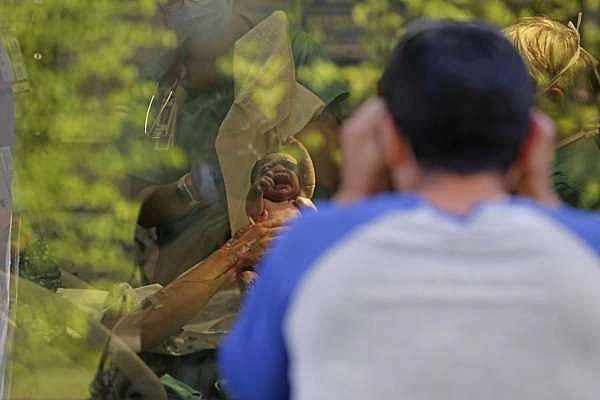
The doctor planned to check Kayla at 5 p.m. When he arrived, he told Kayla the baby was coming.
Alex was less than a mile and a half away, but Kayla worried he wouldn’t make it in time.
She called another family friend — Donna Williams, a woman who was like a mom to Kayla when she was a teenager. Williams was working to the repair a roof on a home nearby, and within minutes, her truck screeched into the hospital parking lot. She jumped out of the cab, yelling, “It’s time!”
She rushed to the window. Alex arrived seconds later. They watched Kayla through the glass.
“She looks worried,” Williams said.
Alex flashed Kayla two thumbs up.
Kayla called Alex. The baby is almost here. Williams walked a few yards back, to watch from underneath a pecan tree in the center of the courtyard.
Alex set his cellphone on the window sill, with Kayla on speaker phone. The doctor was readying himself at the foot of the bed.
Alex shifted from leg to leg, then raised his arm above his head, blocking the glare on the window.
A nurse draped a white towel on Kayla’s belly. Kayla glanced at Alex through the window, and it gave her strength.
“Push, push, push, push, push, push!” he urged.
Kayla reached her outstretched arms toward her lower body. Moments later, the doctor lifted the newborn, umbilical cord still connecting them, onto her belly.
“Oh my god,” Alex said. “Good job, babe! I love you!”
Kayla held her daughter, Luna Rose Benavidez. One of Kayla’s favorite nurses snapped a photograph of the pair, as Kayla first met the eyes of her baby, wrapped in a towel on her chest.
The doctor asked Kayla if she wanted to cut the umbilical cord. With the newborn still in her arms, Kayla held the scissors in her right hand. The doctor gently positioned the cord within Kayla’s reach, and seconds later, she severed the cord connecting her and Luna.
Kayla looked to Alex. It took everything for her not to break down and cry.
“She has a lot of hair?” Alex asked. His voice echoed through Kayla’s phone, which rested on her pillow. “Is she crying?”
“I love you,” he said.
The doctor lifted the baby from Kayla’s arms and held her in front of the window. Luna wailed and squirmed, kicking her tiny legs.
“My baby,” Alex said. Kayla watched from the hospital bed. The mask still covered her face, but you could tell by her eyes that she was smiling.
A nurse pushed the scale next to the window. The doctor gently lowered Luna into it.
“6 pounds 13 ounces,” Alex said into the phone.
Kayla had won their bet.
Earlier in the day, Kayla and Alex bet how much Luna would weigh. Kayla won. (Jerry Lara | Express-News)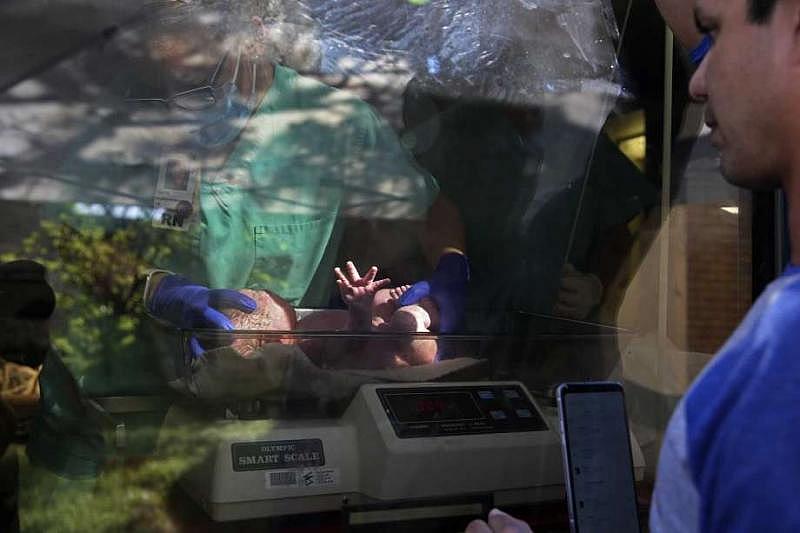
***
After the doctor and nurses left the room, Kayla was alone with Luna.
And Alex was alone outside.
That’s when it hit him. His wife had just given birth to their baby girl, but he couldn’t hold, smell or kiss her. Looking out through the window, Kayla watched as her husband sobbed.
“The only thing standing between us is this glass,” he kept telling her.
That night, Kayla held Luna. As the temperature dipped into the upper 40s, Alex retreated every so often to sleep in the warmth of his truck. But he returned to the window several times through the night.
The next day, Alex’s mother brought Taegan to the hospital to meet her baby sister.
“What color are her eyes?” she demanded to know. Grayish blue, her parents said, but they’ll turn brown over the next few days.
Taegan picked little pink flowers growing outside her mother's window and placed them on the window sill. She stood inches away and breathed hot air onto the glass. With her finger, she drew the shape of a heart in the condensation.
After a while, Taegan’s grandmother took her back to Rocksprings. Alex was alone again. He’d seen at least three other babies leave the hospital since they arrived. Sometimes, their loved ones stopped by, peering through the other windows and leaving fingerprints on the glass.
***
Thirty-nine hours after arriving at the hospital, Alex held Luna for the first time. (Jerry Lara | Express News)
Thirty-nine hours after Alex and Kayla arrived at the hospital, the doctor said they were safe to go home.
Alex waited outside the labor and delivery ward’s exit. When the door swung open, a nurse, wearing a face mask, came out first, carrying Luna in a car seat.
Alex grasped the handle of the car seat, lifting the baby toward his chest. Kayla beamed at them from a wheelchair.
Alex stared at his daughter, asleep in a pink blanket.
While holding their baby, he leaned down to kiss Kayla.
For one of the first times since arriving at the hospital, a mask didn’t cover any part of her face.
Are you nagivating maternal or women’s health care amid the pandemic? We want to hear from you. Marina Starleaf Riker is an investigative reporter for the San Antonio Express-News with extensive experience covering affordable housing, inequality and disaster recovery. To read more from Marina, become a subscriber. marina.riker@express-news.net | Twitter: @MarinaStarleaf
Design by Joy-Marie Scott
[This story was originally published by San Antonio Express-News.]

